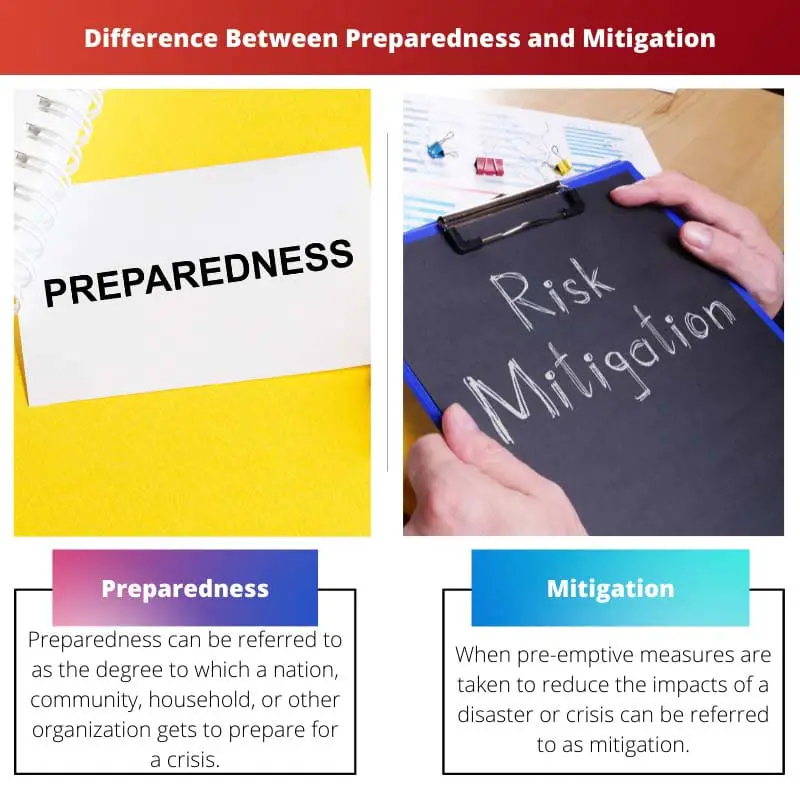The term disaster stands for an event that causes damage or harm to life and property. Some of the examples of disasters are earthquakes, tsunamis, floods, etc.
The classic Emergency Management cycle mainly includes mitigation, preparedness, response, and recovery.
Preparedness and mitigation are involved in response to the crisis. They are also concerned to prevent the worse consequences of a disaster or crisis. Although preparedness and mitigation are similar terms, they are different from each other.
Key Takeaways
- Preparedness refers to being ready for a disaster or emergency, while mitigation refers to taking measures to prevent the impact of a disaster.
- Preparedness involves creating an emergency plan and stocking up on supplies, while mitigation involves identifying and reducing the disaster risk.
- Preparedness is necessary for immediate response to a disaster, while mitigation is a long-term strategy for minimizing the impact of a disaster.
Preparedness vs Mitigation
In the case of a crisis, preparedness refers to the plan of action a nation, community or household intends to take before an emergency occurs. The goal is to be well-prepared so as to respond to the crisis. Mitigation refers to the measures taken to reduce the impact of an ongoing disaster or crisis.

Whatever is done before the disaster is known as preparedness. When a hazard occurs, such as an earthquake, cyclone, tsunami, etc., and interacts with the human environment, it can be called a disaster.
There is much preparedness before the disaster, such as a team of qualified doctors, the creation of disaster awareness, educating people, getting ready with appropriate medical equipment and aid, etc.
Usage and implementation of suitable measures to reduce the damages, effects, and deaths. It also includes infrastructure facilities such as evacuation, food, fodder for livestock, shelter, medicines, and other related help.
For each country, there is a national disaster management agency. The name of the agency may slightly differ depending upon the population, size, geographical location, etc.
Comparison Table
| Parameters of Comparison | Preparedness | Mitigation |
|---|---|---|
| Interpretation | Planning how to respond. | Minimize the results from a disaster by putting measures in place. |
| Timeframe | Enacted before a crisis | Enacted in anticipation and during an ongoing crisis |
| Purpose | Crisis response | Crisis control and prevention |
| Operation | Event-specific | Ongoing strategy |
| Example | Food storage | Repairing vulnerable structures |
What is Preparedness?
Preparedness can be referred to as the degree to which a nation, community, household, or other organization gets to prepare for a crisis.
The term preparedness is used in the context of extreme weather events preparation and other natural disturbances. Both strategy and resources can be included in the preparedness.
Anything that is required to respond to a crisis can be involved in necessary resources. The necessary supplies majorly depend on the situation, such as a shelter-in-place order or evacuation.
Things can include food and water, mobile phones for communication, supplies for sheltering in place, and batteries for the flashlight.
Planning and strategy are also involved in preparedness. In most cases, a plan fails to be made when a crisis is already underway.
For instance, families are advised to be in a safe place, and in case they fail to spot their actual house, then it is better to meet at the rally point outside.
For cities and nations, it becomes more complicated. Because they must have a strategy and resources in the event of a crisis, there should be adequate resources for medical personnel and first responders.
A plan is also necessary for what to do with citizens to protect their lives, whether that involves sheltering in place or evacuation.

What is Mitigation?
When pre-emptive measures are taken to reduce the impacts of a disaster or crisis, it can be referred to as mitigation. Neither completely prevents a disaster, nor does it lessen the disaster’s severity both before and during the ordeal.
There are several types of mitigation.
Climate change mitigation includes investment in renewable resources of energy, specifically those that are carbon neutral. Reducing dependency on carbon-intensive energy sources (petroleum and natural gas) is the main purpose of this investment.
Climate change mitigation measures refer to lessening the climate change impacts that result from anthropogenic carbon emissions.
Another type of mitigation includes disaster mitigation. One form of disaster mitigation is to design an earthquake-resistant building in areas with high earthquake risk.
One type of disaster mitigation is potential asteroid impact mitigation, which has been recently the subject of discussion.
NASA and other space agencies have investigated the mitigation of an asteroid impact. Strategies in this type of mitigation include planning emergency response procedures, impact effects studies, and destroyed deflection missions.
Evacuating a city based on an approaching city-killing asteroid is an example of an emergency response procedure.
Main Differences Between Preparedness and Mitigation
- Preparedness includes being able to act to prevent loss of property during a crisis, while mitigation involves either lessening crisis effects when it occurs or preventing the crisis from happening.
- Particular events, such as tornados or hurricanes, can be anticipated with the help of preparedness, whereas ongoing strategy is involved in mitigation, and the strategy involves responding to different crises or events.
- It is necessary to enact before a crisis and re-established after each crisis in preparedness. On the flip side, it is better to initiate mitigation before a crisis, but theoretically, during a crisis, it can be initiated in the midst.
- In preparedness, re-stocking of resources is necessary, and re-formation of strategies may be required if they proved sub-optimal in the last crisis. But if the crisis is already happening, then it is not too late to mitigate it while preparing for it.
- Preparedness is passive because this aim is to get away from the crisis. On the other hand, mitigation is active as in this attempt are made to change the crisis itself.

- https://www.emerald.com/insight/content/doi/10.1108/09653560310480686/full/html?fullSc=1&mbSc=1&fullSc=1&fullSc=1&fullSc=1
- https://www.sciencedirect.com/science/article/pii/S0378216698000988